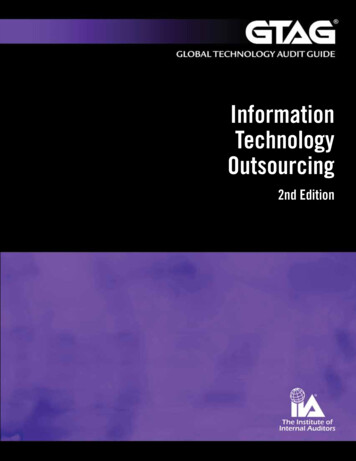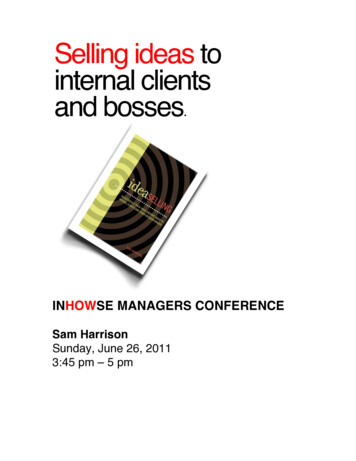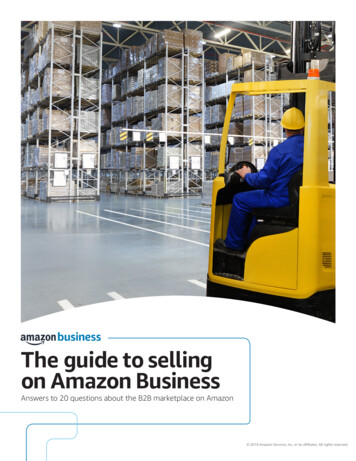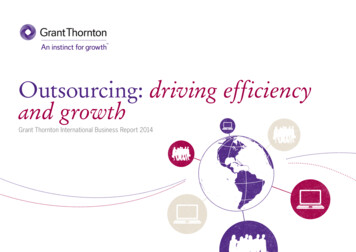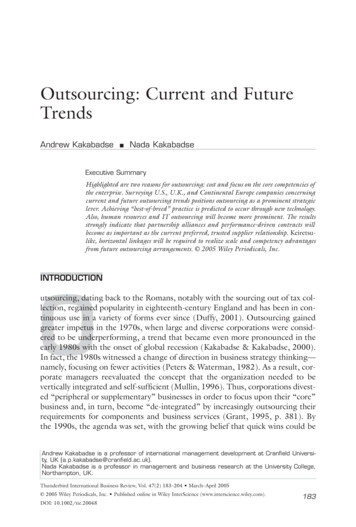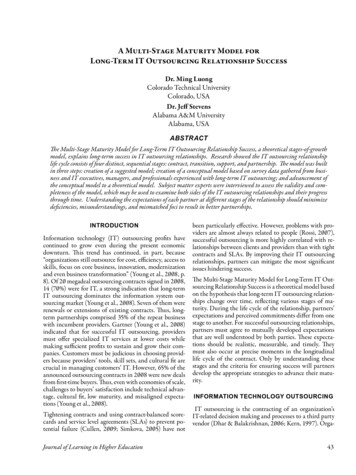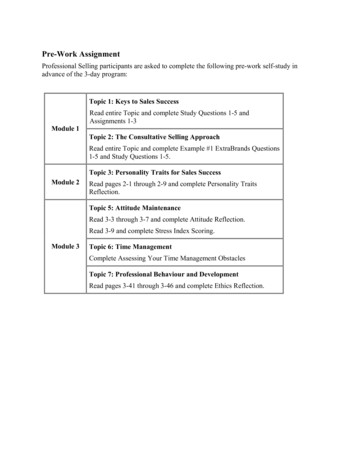
Transcription
CESClassroom.comOutsourcing Your Amazon Book Selling Business With FBABy Bryan Young1
CESClassroom.comOutsource: The Entrepreneur's Approach to AmazonIn his book, The Cashflow Quadrant, Robert Kiyosaki shares what he refers to as TheCASHFLOW Quadrant, which is pictured below:The CASHFLOW Quadrant represents the different methods by which income or money isgenerated.Here are what the letters in each quadrant represent:E for employeeS for self-employedB for business ownerI for investorYour sources of income all fall into one of these quadrants. “For example, an employee earnsmoney by holding a job and working for someone else or a company. Self-employed peopleearn money by working for themselves. A business owner owns a business that generatesmoney, and investors earn money from their various investments-in other words, moneygenerating more money” (1999, Kiyosaki, p.9).Typical online sellers fit into the S quadrant, which is “self-employed”. People who are selfemployed get to “be their own boss” and have the freedom to “do their own thing.”These are the “do-it-yourselfers.”I cherish the freedom and flexibility that our online, FBA business offers. We are able tostructure our business around our family time, as opposed to being forced to organize our2
CESClassroom.comfamily time around someone else's business. While most people who are in the E quadrantvalue the security that they feel that they have working for a company, self-employed peopletend to prefer the freedom found in working for themselves.One of the short falls in making the majority of your income in the S quadrant is that time isyour biggest limiting factor. People in this group tend to “have to” do it all, and since they arein working in all areas of their business they will eventually reach a ceiling of opportunity. Youmay have, like me, moved from quadrant E to S, but is it possible to run an Amazon sellingbusiness in the B quadrant? Some jobs you just have to do yourself. Is online selling,because of its unique nature, one of those jobs?The “B” (business owner)This group of people could be considered the opposite of the “S”. Those who are “B” surroundthemselves with smart people from each of the four quadrants, unlike the “S” who feel likethey need to do everything themselves. Being a business owner involves more focus inbuilding a system of business that can operate on its own, as opposed to being the systemthemselves. It's the difference between the guy/gal who owns the Subway franchise downthe street and the self-employed person who runs their own sandwich shop. “B” spends moretime working on the business, whereas “S” spends more time working in the business.“Those who are true “B's” can leave their business for a year or more and return to find theirbusiness more profitable and running better than when they left it. In a true “S” type ofbusiness, if the “S” left for a year or more, the chances are there would be no business left toreturn to” (Kiyosaki, p.27).This is true for “B's” because they enter into business with the mindset of stepping out of it assoon as possible. They don't want to do everything. They want instead to create jobs forpeople who are more skilled than they are and allow them to run the business from the inside,while they contribute from the outside. As an “S” you own a job. As a “B” you own a systemand people work for you.For those of you who would like to set up a thriving “S” Quadrant online selling company,that’s great. There are excellent opportunities to make tons of money doing all, or most, of thework by yourself. But, for those who would like to consider building a “B” Quadrant onlineselling company, let's continue.**If you haven't already, I highly recommend reading both Rich Dad, Poor Dad & TheCashflow Quadrant by Robert Kiyosaki.**Building a Good Foundation for Your “B” Quadrant Online Selling CompanyI know many successful online sellers who are having difficulty with the notion of outsourcingsomething that they believe would be impossible for someone else to do at the same level ofsuccess, or better. They've created an impressive business that would be impossible for themto step out of, because they have become the indispensable “Linchpin” in the organization.But, what if at the beginning you knew where the company was going? If you had the initialgoal of stepping out of your business, would it help to set up the necessary foundation for aseamless transition?We’re now in the process of outsourcing most of our Amazon business (nearly 2 years after it3
CESClassroom.comwas founded). Looking back, I know that it could have happened sooner, with less internalresistance. If I could do it all over again this is what I would do:The 90 day plan to Building a Healthy Stream of Passive IncomeI would spend 3 months sourcing used books at thrift-stores. In this period of time I wouldmake sure that I was becoming very familiar with the area. Which stores have sales andwhen? Which stores yield the best inventory? I would document, based on sales experience,a good purchasing criteria, in order to take all the guess work out of buying books for resale. Iwould number all of the thrift-stores in the area on a map with turn-by-turn directions to eachof them. I would take all of this critical information, and more, and I would print a manual(which I will share with you soon).Next I would find a family member, whom I trusted, and I would train them in. My brother-inlaw, after one month of book-sourcing, is already more advanced than I was, even after doingit for 2 years! The reason for this is simple; book-sourcing is all that he does. He doesn't needto keep all the plates spinning, the ones that need to be spun in order to run a multifacetedAmazon business (buying, prepping, shipping, customer service, etc.). He buys books; that'sit. His laser focus on that one thing, allowed him to flourish far more than I ever could.After you have outsourced that task, begin laying the ground work to outsource another (retailor online arbitrage, wholesale, etc.). We hire Andrew to source books in the metropolitanarea. Our newest business partner, Tom, sources other thrift-store items on commission.While in the city, Tom picks up the books that Andrew had sourced over the previous week,and delivers them to Eden, who's paid to prep and ship them to Amazon (to be ultimatelyfulfilled by Amazon). We manage the entire system from afar. Finally, we've found a way towork on our Amazon business, without having to work in it (as much).Don't let the handwork, and time-consuming nature of running a profitable Amazon businessget in the way of capitalizing on this amazing opportunity to sell in such an incredible marketplace. What if you approached online selling, not with the mind-set of replacing your old job,but instead, like an entrepreneur that's determined to create a self-perpetuating business? Ithink that this unique approach could help you create a FBA business that could yield passiveincome for years and years.Here are some of the questions people have asked about our business model that you mayfind helpful:What kind of tools do you provide your book-sourcing person?Andrew has a Dell Axim x51v PDA, loaded with the Amazon database (most media), andpaired with a Scan fob Bluetooth laser scanner. There are a few companies that offer, for amonthly fee, unlimited access to Amazon's database that you can download onto your device.If you are interested in sourcing books seriously, I would highly recommend checking out theirservices. Go to www.ASellerTool.com, and be sure to check out their PDA rental packages.We also provide him with a 25 page training manual which includes: our sourcing criteria, a4
CESClassroom.commap with all of the area thrift-stores labeled and numbered, turn-by-turn directions to eachstore in order, monthly calendars with local library sales, tips and tricks to sourcing books, andstrategies to establishing business relationships with store owners.How much do you pay the person who sources your book?We pay our book-sourcing person 1/book, for every book that successfully meets ourcriteria. In the last shipment of books that we processed, out of 670 books all of them met thecriteria except for 15 (which is pretty good). At first we struggled with how we should pay ourbook-sourcing person. We figured that if we paid him per hour, he would likely be focused onputting in the most hours as possible; whereas, if we paid him on commission he wouldinstead be focused on sourcing the largest number of books possible (which is ideal). A thirdoption would be to pay him on commission, but that would result in him having to wait to getpaid until after the books themselves sold, which in some cases could be a considerableamount of time. Also, a commission-based compensation could create for us a book-keepingnightmare!Paying a finder’s fee per book works out well for our person. This way he can sourcewhenever and for how long he chooses. If he has an extra half-hour and he wants to run intoa Salvation Army Thrift-store, he can (and he typically can find more than 20 books in thatamount of time!). Or, if he would rather dedicate a whole day to book-sourcing, he has thatoption too.Won’t you be giving all of your business secrets away?I would say that this was our biggest concern. The last thing that we needed was anotherbook-seller competing locally for our potential inventory, especially using the same criteria!Although there are risks involved in “pulling back the curtain” on any profitable business, thisone seemed exceptionally prone to be stolen. As we brainstormed about this, there were acouple things that eased our anxiety about outsourcing this portion of our business. Mostpeople are not entrepreneurially minded, they aren't of the mindset of starting their ownbusinesses. Most would rather trade dollars for hours, as opposed to taking the very real riskof starting their own company from scratch. Where we saw the potential to start a business,they would instead see an opportunity to earn a paycheck. As I'm sure most of you knowfirsthand, there's a learning curve that's necessary to climb before you can get your onlineselling business off the ground, most people would rather watch the next episode of Big BangTheory than spend their free time studying FBA. Also, we could eliminate some of our worriesby only hiring people whom we trust.Andrew, our “Book Sourcing Specialist”, is not only trust-worthy, but he is extremely hardworking as well. In his case, he is very entrepreneurial but we decided to hire him anyway.Why would you do a thing like that (you may be asking yourself)? We have bigger plans inmind for him. We would like him to eventually manage the portion of our business dedicatedto the future expansion of our book-sourcing venture. In the next few years instead of himsourcing books personally he'll be hiring others to source while he sets up sourcing5
CESClassroom.comspecialists and book-listers in major cities throughout the country! Sorry, I'm getting a littleahead of myself.How much do you pay the person who lists your books?We hired a stay-at-home mom to prep and ship the books for us at .25/book (which so faramounts to about 15-20/hour). Our goal is to help her earn enough so that her husband canbe at home too, which may mean that they will ship more than just books for us. The neatthing is, is that we've basically helped them build the foundation of their own shippingcompany. We will supply all the business necessary to get their company off the ground, butas they scale up they could take on more clients. Kind of like what the Bullards offer butlocated in MN (For more information on the products and services that they offer check themout at www.myinventoryteam.com).We don't like packing & shipping, it has to be one of our least favorite tasks, but from theirperspective, that's all they'll do, so I expect that they'll get pretty good at it. Also we'reencouraging them to plan on eventually outsourcing too. Again, since I firmly believe that it isso beneficial to establish a business from the beginning with the mindset of somedayoutsourcing everything, they are definitely starting out on the right track.Does the person who lists your books also price them?We have an automatic repricer set to get our items up to speed just before they reach thefulfillment centers. I just want her to get close, and the repricer will handle the rest. There aremany options for re-pricing software, and we use www.repriceit.com.So let me get this straight, you never even see the books you sell online?Correct. Andrew buys the books and then gives them to Tom, who shops the thrift-stores forus, who then delivers them to Eden to be listed & shipped to Amazon. We provide all of thecapital and oversee the books once they hit the Amazon warehouse.How does this additional cost affect your buying criteria?We accommodate for the added costs by expanding our book-sourcing criteria. A copy of ourtraining manual can be found at the end of this document.How much do you typically buy each book for?I think the better question is: what is the total cost for each book on average (COGS). Inanalyzing Andrew's last shipment we determined that the average total cost per book was 2.92. This amount included all costs associated with collecting and shipping these books intoAmazon (purchase price, finder’s fees, boxes, tape, labels, realistic percentage of monthlyfees for ScanPower list, Repriceit & ASellertool and inbound shipping). Because there's abenefit to Andrew for reducing the purchase price of the books, he is motivated to find cheapbooks so that he can collect more of them.He was shopping at a one-of-a-kind thrift-store the other week and the owner saw that he had6
CESClassroom.comabout 50 books that he was planning on buying. When Andrew expressed that he wasinterested in purchasing more, he was quickly ushered into the back room which housedmore than five times the amount of books they had out front. Andrew agreed to come back inthe future in order to source and purchase books in the backroom for an extra discount! If wedesire to motivate our product-sourcers to establish these types of business relationships it isimportant for us to build the infrastructure in our business that encourages it.Andrew only works a few days per week and he consistently sources over 350 books.Do you only sell Books on Amazon?We started in books but now our numbers are more like this; Toys & Games 40%, Books10%, Electronics 10%, Groceries 10%, Kitchen 10%. But by outsourcing books, I'mexpecting that category's share of our business to grow. We do about 90% retail arbitrage.Someday soon we hope to outsource a big chunk of our retail arbitrage as well.Do you have to up your buying criteria to take into account the added costs (finder’sfees etc.)?Yes, to accommodate our extra cost per book sold, we upped the criteria a bit. Although, if therank is extremely low, he'll buy a book that will sell for less than 15 (just sold The TippingPoint for 10). His last shipment of books had 670 books that cost us a total of just under 2000. The total list price of all of the books together was about 13,000.What about those odd listings on Amazon, where the book is being sold for over 1000?I would be very suspicious of those prices! Unless it was a highly sought after first edition or acopy of Chris Green's Retail Arbitrage or something. Although I don't think his new book,Online Arbitrage, will be priced that high, but who knows.Doesn't giving so much control of your business away worry you?It did at first, but not anymore. Books are a great place to start for those looking to outsource.They are relatively inexpensive, have terrific profit margins and fit into a book-sourcing systemthat can easily be taught to others. Sourcing books is pretty straight forward, and since thereisn't much gray area, there isn't as much risk (unlike say, retail arbitrage). Give it a shot and ifyou have any questions or concerns please feel free to contact me. Also, if you experiencesome success by implementing and being encouraged by what I have shared, I would love tohear about it. We get our greatest joy and satisfaction out of helping others succeed.Bryan d me on FB!**7
CESClassroom.comOur Manual for Book-SourcingThe following is a copy of the book-sourcing training manual that we provide toour book-sourcing specialists. I hope it helps to give you some practical ideasand assist you as you develop your own training materials.Book Sourcing CriteriaWhat you'll notice right away is that the majority of books listed for sale on Amazon are notFBA eligible. I see this as an excellent opportunity. So many Amazon shoppers want theirbook and want it now! The number of Prime subscribers continues to grow because peopleare impressed with and have become accustomed to Amazon's world-class customer serviceand their lightning fast shipping. People trust Amazon not only to deliver what they order ontime, but they also have the comfort of knowing that if anything is wrong with their order thatthey will get a speedy refund. Plus, with one-click purchasing, return customers can quicklyplace an order and then get on with their lives. These elements provide a favorableenvironment for FBA sellers. These intangibles give us, FBAers, an upper-hand over ourcompetition (MF/Merchant Fulfilled Sellers).When sourcing books I usually stick to these rules when trying to decide if a book is worthbuying to resell, or not. There will be times, here and there, when there will not be enoughcriteria (such as no Amazon sellers), but for the most part if you stick to this plan you willsucceed in finding excellent books for resale. The interesting thing about Amazon booksellersis that everyone seems to have a slightly different standard. Some online sellers areobsessed with seller rank and will only buy books with a 500K rank or better. Othersscrutinize over price, they refuse to buy a book that they can't resell for 25 or more. Othersellers have made a habit of skipping over books that don't have barcodes (these are moretime consuming because you have to enter in the ISBNs by hand). What this means is thatthere can be several booksellers frequenting the same store and yet all of them can come outwith a load of books, satisfied at what they've found.So, here we go. Before we jump in I will need to define some of the applicable terms.Purchase Price - refers to the cost of the book that you are scanning, is it 1.99? 0.50?Free?Amazon Rank – Amazon assigns each book a ranking. While this number is worthconsidering, it is not worth obsessing over, and this is why, the rank does not tell you the longterm popularity of a book, but instead simply tells you how many of them have sold, incomparison to other books, within the last 24 hours. There a many things that can increase ordecrease rank besides the number of purchases too, but Amazon has been very secretivewith the analytics that they use to figure rank.FBA – Fulfillment By Amazon. Books that are listed “FBA” are books that are at an Amazonwarehouse and are eligible for super saver shipping as well as all of the Prime benefits. Whenpricing books sold FBA we will treat them like they are almost in their own marketplace. Bookssold FBA typically cost more than their MF predecessors.8
CESClassroom.comMF – Merchant Fulfilled. Books that are listed “MF” are books that 3 rd party sellers are listingfrom home or their own warehouses/offices. MF books typically are priced lower than FBAbooks in the same condition.Amazon Book Condition Guidelines:New: Just like it sounds, brand new. Amazon customers have very high standards whenpurchasing New books so they better be pristine when they receive them or they will beseeking a refund and leaving negative feedback. New on Amazon means, gift quality.Used - Like New: Dust cover is intact, with no nicks or tears. Spine has no signs of creasing.Pages are clean and not marred by notes or folds of any kind. May contain remainder markson outside edges, which should be noted in listing comments.Used – Very Good: Pages and dust cover are intact and not marred by notes or highlighting.The spine is undamaged.Used – Good: All pages and cover are intact (including the dust cover, if applicable). Spinemay show signs of wear. Pages may include limited notes and highlighting. May include"From the library of" labels.Used – Acceptable: All pages and the cover are intact, but the dust cover may be missing.Pages may include limited notes and highlighting, but the text cannot be obscured orunreadable.Unacceptable: Includes missing pages and obscured or unreadable text. We also do notpermit the sale of advance reading copies, including uncorrected proofs of in-print or not-yetpublished books.Young Life Sales Guidelines for Books:We typically downgrade the condition of the book so; if we have a book that we feel is in “LikeNew” condition, we'll list it in “Very Good” condition instead. There are several reasons forthis: 1) Books can be damaged slightly in transit or while they await their sale at theFulfillment center, 2) Books have another opportunity to be damaged on their way to thecustomer after they have been sold, 3) Customers may not have an accurate understandingof Amazon's book condition guidelines, and could possibly get upset over a misunderstanding(they may assume that a book in “Very Good” condition should not have any cover wear) and4) We want to do all that we can to create a positive customer experience. When thecustomer receives our book we want them to be thrilled at its condition, thrilled enough toleave positive feedback.That being said, I would say that 90% of the books that we have for sale on Amazon are listedin “Very Good” condition, followed by “Good”, “Like New”, and “Acceptable”. We will veryrarely list a book as “New”.So, keep these general guidelines in mind when sourcing books.Purchase Pricecondition) 0.00-0.50 0.51- 1.00 1.01- 1.50 1.51-2.00 2.01-3.00RankAmazon Price (according toAnyAnyAnyAnyBetter than 2Million10.95 12.95 13.95 15.95 17.95 9
CESClassroom.com 2.01-3.00 3.00 Any*DNB24.95 DNBPurchase Price How much you will be spending to buy the book.Rank Amazon's rank for the particular book that you are scanning. Only really comes intoplay when the price of the book exceeds 2.00.Amazon Price How much that book, in its current condition will be sold for online.DNB Do Not BuyWe always match the price of an FBA book that is of the same condition. So if you arescanning a book that would be considered “Very Good” and you there is another FBAerselling that book in Very Good condition assume that we will match their price. So if the otherFBA seller is selling their book in the same condition at or above the minimum Amazon Price,then you should purchase this book. If there are other FBA sellers but none are selling theirbook in the condition that you have found, then you would determine the price based off of theother sellers. If the book is being sold as “Good”, we would sell a “Very Good” book @ a 10%up-charge. If the book is being sold as “Like New”, we would sell the book at a discount of10%.Ex: You are scanning a book with a purchase price of 1.25, it has a rank of 2.5 million and itis in Very Good condition. There are no FBA sellers who have VG copies, but there are FBAsellers who are selling that book in Good condition ( 7.95) and Like New ( 11.95) yourestimated sale price would be 8.75-10.75 (which is 10% more than the good condition and10% less than the Like New copy). Since the minimum sale price for a book costing 1.011.50 is 13.95, you would pass. But let's say that the book is selling in Good Condition for 7.95 and the Like New for 17.95, your estimated sale price would be 8.75-16.15 (followingthe same 10% rule). These prices would put you above the minimum accepted Amazon pricefor a book costing 1.25, you should buy it.As you can see, there is value in finding creative ways to decrease the purchase price of yourbooks. With the combination of sales and discounts you can open up the criteria which willassist you in finding more books and thus making a larger commission.So, we covered a couple examples of price if there are other FBA sellers, but what if therearen't? If there are no FBA sellers for a particular book, we will have to depend on the pricesoffered by MF sellers. First, considered the condition of the book and then look at the 1) UsedMF offers and then 2) the New MF offers. If you found that same book (as discussed before)in Very Good condition, but there are not any FBA sellers to help determine price, check outthe MF VG prices. Being an FBA seller we can sell a book of comparable condition for morethan we could via MF, generally for 5-8 more!Here's an example: You found a book for 1.25 that is in VG condition. When you scan it younotice that there aren't any FBA sellers. MF sellers are selling the book in Good Condition for 4.25, Very Good for 6.50 and Like New for 9.95. Based off this information alone,according to our criteria, this book could be sold for between 11.50-14.50 (The VG MF priceof 6.50 5-8). Since this book meets the criteria (minimum price of 13.95), you shouldpurchase it.10
CESClassroom.comNext, you should check the New MF prices. Typically, you wouldn't want to sell a Used FBAbook for more than it is selling for New MF, but this isn't always the case. If the New MF pricesare at or below the used MF prices you should not purchase the book. If that same book thatwas being sold MF in Good condition for 6.50 and Like New for 9.95 was also selling Newfor 6.50 or less, this should send up all sorts of red flags. Maybe the used MF copies aregrossly overpriced. Why would anyone buy a used copy of a book when they could get a newcopy for the same price or less? Typically this doesn't happen, as people generally price theirbooks competitively (since, what good is a book that sits and sits and never sells?).For our next scenario let’s assume that there are no FBA sellers for this particular book andno Used MF sellers either, now what? Well, are there New MF sellers? The rule of thumb isthat we always want to be able to price our used FBA books lower than their New MFcounterparts. So if you scan this Very Good book only to discover that there is only New MFeditions listed you should price accordingly. If you are able to purchase this book of 1.25 andit is selling MF New for 9.95, you should not purchase it. But, if it is selling MF New for 15.95 then you should pull the trigger since you would be able to sell the book in VG for lessthan 15.95 and yet still meet the minimum pricing criteria of 13.95.Finally, what happens when you scan a book and discover there is a listing but there arecurrently no sellers (neither MF nor FBA)? As long as there is a listing and while using yourbetter judgment you determine that the book may have some value, go ahead and buy it.There could be excellent potential in being the only seller on a listing. If on the other hand youscan a book and there is “No Listing Found”, this means that there are no books listed againstthat particular UPC or ISBN, don't buy. The time that it takes to create a listing page for asolitary, question-mark of a book is not worth it.11
CESClassroom.comSourcing Books: Thrift Stores(Understanding the geography)1.Salvation Army Family StoresThe Salvation Army operates over 30 stores in Minnesota and North Dakota.Salvation Army is a great place to source books. Typically they have the best pricesand it would appear that they are often overlooked by other book scanners. Occasionally thestores will have sales, it would be a good idea to make note of any recurring sales per storelocation. There are some Salvation Army stores, especially in the cities that do not have avery good selection of books. The Salvation Army in Rochester always yields a decentamount of inventory. Also, S.A. tends to have a good selection of cheap games & vintagetoys. Just make sure that you check to make sure that they are complete, a typical S.A. willcharge .50/game.2.Goodwill Thrift StoreGoodwill seems to price their books a little high, sometimes upwards of 6.99 per title.The only time that it would be recommended shopping at Goodwill for books would be whentheir book prices have been discounted significantly: Sunday: Certain color tag is 50% offMonday: Same color tag is 50% offTuesday: Same color tag is 1.99Thursday: Toddler Thursday means 50% all kids’ stuffGW tends to lower the sticker price on books in the Spring and Summer and then raisethem in the Fall and Winter, when books are at their highest demand. Also, keep an eye outfor their clearance bins. Typically books and other media that have been put on clearance willbe .15/each. (Ex. Currently all blue tagged books and all VHS tapes are only .20/each – Beon the lookout (BOLO) for these types of sales as well).When sourcing for books at GW, I will go on a Sunday or Monday and quickly scanthrough the 50% off books, being mindful of the price. I also spend a little time sourcing in thetoys and game section. Typically games and toys are priced to sell, but if you happen find theright color tag or you are shopping on a Thursday you can get an even better deal. On theway to the register to check out I always make sure to swing by the glass cases in the front ofthe store. Typically one case is for the silent auction and the other has items locked up thatmay be worth considering.3.Savers Thrift StoreSavers tends to be one of my most favorite thrift stores for sourcing books. Sometimestheir books are priced a little high, but with a combination of discounts it is very easy to bringthat price down to a more manageable average. Discounts that should be considered when12
CESClassroom.comcalculating price:-Buy 4 books get the
In his book, The Cashflow Quadrant, Robert Kiyosaki shares what he refers to as The CASHFLOW Quadrant, which is pictured below: The CASHFLOW Quadrant represents the different methods by which income or money is generated. Here are what the letters in each quadrant represent: E for employee S for self-employed B for business owner I for investor
![Index [beckassets.blob.core.windows ]](/img/66/30639857-1119689333-14.jpg)
